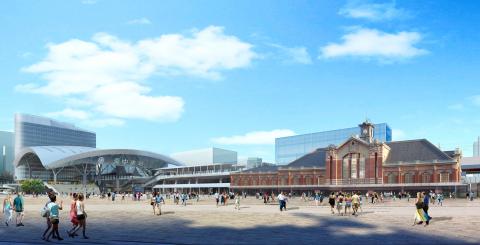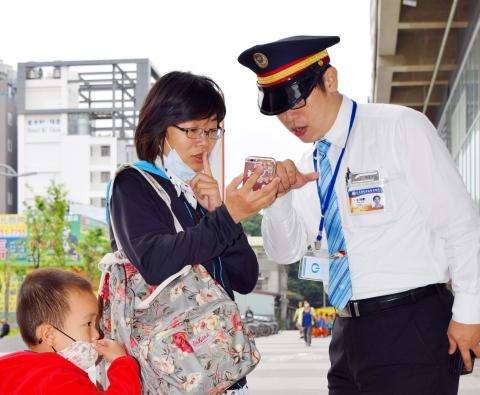Sporting his Taiwan Railways Administration cap, Taichung station director Wang He-chieh ( 王河傑 ) gets asked a lot of questions these days by Taichung commuters, with one of the most popular being, “Where are the trains?”
The confusion is short-term, railways officials hope, as travelers get accustomed to Taichung’s new NT$221 million elevated train station. Opened in October, the sleekly-designed station replaces the adjoining century-old former station.
“It’s definitely better than before,” said Li Bing-Hsing (李秉興), after arriving by train from Miaoli. “It’s not that crowed and a lot more convenient.”

Photo courtesy of Shu Chang & Associates, Architects
JAPANESE ARCHITECTURE
Preserving the past while planning for the future is what architect Shu Chang (張樞) hoped to achieve when designing the new station.
“I tried to respect the old building as much as possible,” said Chang, a Taichung native, whose company was subcontracted by CECI Engineering Consultants. “It’s one of the better examples of Japanese-era architecture.”

Photo: John Evans
To better show off the historic building, the less-sightly recent additions will be removed. The original platforms and tracks, however, will remain as part of a new railway museum that will be completed soon.
The new station’s second-floor concourse was designed to be “open air” to take advantage of Taichung’s usually mild weather, said Chang, who also teaches architecture at National Taiwan University.
A large pedestrian area on the first floor will be a multi-use public space, he said.
Chang said the new station is intended to embrace the concept of urban design, adding, “It will totally redesign that part of the city.”
With weekday ridership at 60,000, passengers at the old station often jostled for space while waiting for their train.
And when construction is completed at the end of next year, the new station will be 33,325 square meters, more than 30 times the size of the original station.
In addition, the new station will be able to accommodate more trains with its five tracks and three platforms. Currently, there are three tracks and two platforms, the same number as at the old station.
While businesses inside the new station are yet to open, train officials said convenience stores and other shops are expected to open within the next few months.
The elevated station and the adjoining tracks will help connect the city as a whole, railway officials said. A series of street-level railroad crossings had effectively cut off portions of the city’s southern and eastern areas.
The new Taichung station is just one in a series of elevated train stations and rail lines winding its way through the city.
“I’m proud of this project,” said Wang. “We’re revitalizing this area of the city.” Railway and city officials hope the new station will help create more convenience for travelers with a boom in business opportunities.
BUSINESS OPPORTUNITIES FOR SOME
The construction of the new station has already been an economic shot in the arm for an older, working-class section of the city.
From tea stands to sandwich shops, business is flourishing adjacent to the new station.
“I’m very happy. It’s 50 percent better,” said Roy Chiu (邱富崑), manager of a nearby tea stand. The upturn in business has allowed his employees to work additional hours for bigger paychecks, he said.
And while businesses near the new station are finding an economic resurgence, on the opposite side of the tracks it’s the flip side.
Convenience stores nearby the old station have reported a drop in business by about one-third.
Jiang Ming-wei (蔣名瑋) has seen the slowdown firsthand. Jiang works at a scooter parking garage a short walk from the old station where weekday business is off only slightly, but on weekdays it has plummeted 50 percent.
OLD TRAIN STATION, NEW MUSEUM
The old train station, built during the Japanese colonial era, will be leased to a private company and turned into a train museum and exhibition space, and rebranded Taichung Railway Cultural Park.
Preserving the old building, which is a National Heritage Site, is a priority, train officials said.
“The atmosphere will be a mix of old and new,” said Sophia Lin (林于茜), a TRA spokesperson.

April 28 to May 4 During the Japanese colonial era, a city’s “first” high school typically served Japanese students, while Taiwanese attended the “second” high school. Only in Taichung was this reversed. That’s because when Taichung First High School opened its doors on May 1, 1915 to serve Taiwanese students who were previously barred from secondary education, it was the only high school in town. Former principal Hideo Azukisawa threatened to quit when the government in 1922 attempted to transfer the “first” designation to a new local high school for Japanese students, leading to this unusual situation. Prior to the Taichung First

The Ministry of Education last month proposed a nationwide ban on mobile devices in schools, aiming to curb concerns over student phone addiction. Under the revised regulation, which will take effect in August, teachers and schools will be required to collect mobile devices — including phones, laptops and wearables devices — for safekeeping during school hours, unless they are being used for educational purposes. For Chang Fong-ching (張鳳琴), the ban will have a positive impact. “It’s a good move,” says the professor in the department of

On April 17, Chinese Nationalist Party (KMT) Chairman Eric Chu (朱立倫) launched a bold campaign to revive and revitalize the KMT base by calling for an impromptu rally at the Taipei prosecutor’s offices to protest recent arrests of KMT recall campaigners over allegations of forgery and fraud involving signatures of dead voters. The protest had no time to apply for permits and was illegal, but that played into the sense of opposition grievance at alleged weaponization of the judiciary by the Democratic Progressive Party (DPP) to “annihilate” the opposition parties. Blamed for faltering recall campaigns and faced with a KMT chair

Article 2 of the Additional Articles of the Constitution of the Republic of China (中華民國憲法增修條文) stipulates that upon a vote of no confidence in the premier, the president can dissolve the legislature within 10 days. If the legislature is dissolved, a new legislative election must be held within 60 days, and the legislators’ terms will then be reckoned from that election. Two weeks ago Taipei Mayor Chiang Wan-an (蔣萬安) of the Chinese Nationalist Party (KMT) proposed that the legislature hold a vote of no confidence in the premier and dare the president to dissolve the legislature. The legislature is currently controlled